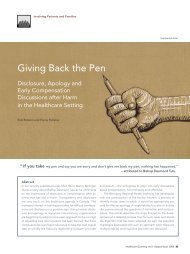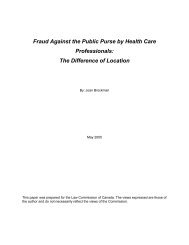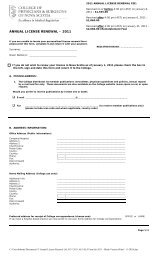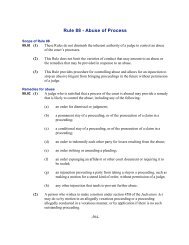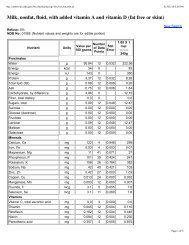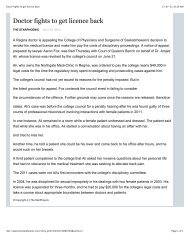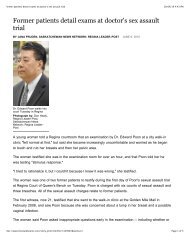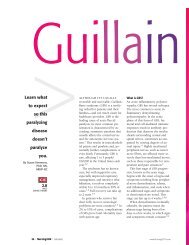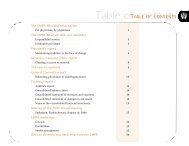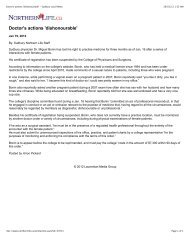Experiments That Changed Nutritional Thinking - TUUM EST
Experiments That Changed Nutritional Thinking - TUUM EST
Experiments That Changed Nutritional Thinking - TUUM EST
You also want an ePaper? Increase the reach of your titles
YUMPU automatically turns print PDFs into web optimized ePapers that Google loves.
1018S<br />
SUPPLEMENT<br />
discoveries that arose from exploration of specific aspects of sentative experiments of this expansion of knowledge within<br />
the new concepts. Several fit Kuhn’s concept of scientific revo- the new paradigm.<br />
lutions that bring about a rapid change in the paradigm of a Iron was known early in the 19th century to be a compofield.<br />
nent of hemoglobin, but the belief that only organically bound<br />
A major paradigm shift in nutrition was the discovery of the iron was available to the body was an obstacle to understanding<br />
essentiality of organic and inorganic micronutrients. Despite a the role of minerals in nutrition. The demonstration by Stocknumber<br />
of observations during the 19th century that diets man in 1893 that inorganic iron was used efficiently for hemocomposed<br />
of purified food constituents did not support growth globin synthesis corrected this erroneous assumption (Paper<br />
or even life, this shift did not occur suddenly as the result of 3). Thirty-five years later, Hart and associates discovered that<br />
a single discovery; it occurred over a period of more than 60 copper was essential for the utilization of iron in hemoglobin<br />
years. The lag was attributable in large measure to resistance formation. It is now known that copper promotes uptake of<br />
to the new paradigm by many scientists who were influenced iron by transferrin and increases the utilization of iron by<br />
by the great prestige of Liebig and who accepted, almost as erythroblasts for hemopoiesis (Paper 10).<br />
dogma, his concept that energy sources, protein and a few After the discovery that yellow carotenoid pigments and<br />
minerals were the sole principles of a nutritionally adequate colorless oils both had vitamin A activity, a conflict between<br />
diet. Only after the inadequacy of Liebig’s hypothesis had been competing hypotheses about the nature of vitamin A precurdemonstrated<br />
in many experiments that should have changed sors was resolved by Thomas Moore, who in 1930 showed that<br />
nutritional thinking, but did not, was the new paradigm gener- the yellow b-carotene was converted to colorless vitamin A<br />
ally accepted. Four of the papers describe experiments that in the animal body (Paper 11). Thiamin was shown by Lohcontributed<br />
to the shift in paradigm.<br />
mann and Schuster in 1937 to be a component of the coen-<br />
Gerrit Grijns, in the 1890s, extended the work of Eijkmann zyme thiaminpyrophosphate, and its role in pyruvate metaboin<br />
Java (Indonesia) showing that chickens fed a diet of white lism in the animal body was elaborated by Peters (Paper 12).<br />
rice developed polyneuritis, a disease resembling beriberi. The Observations by Goldberger that protein as well as proteindisease<br />
was prevented by including rice polishings or beans or free extracts of yeast could cure pellagra posed a problem that<br />
water extracts of them in the diet. He concluded that chickens was resolved when Krehl and colleagues discovered in 1945<br />
needed an organic complex provided in adequate quantities<br />
that the amino acid tryptophan was a precursor of niacin in<br />
by rice polishings and beans but not by polished rice. His<br />
the body (Paper 15). <strong>That</strong> complex interactions and antagoobservations<br />
had little immediate effect on orthodox nutrinisms<br />
can occur among trace minerals was discovered by Dick<br />
tional views, even though they ultimately contributed to the<br />
and associates, who observed that copper deficiency occurs in<br />
basis for the new paradigm (Paper 4).<br />
animals with a normally adequate intake of copper if their<br />
Liebig’s concept that the nutritional value of foods and<br />
intake of molybdenum and/or sulfate is high (Paper 16). In<br />
feeds could be predicted from their proximate composition<br />
1972, selenium was shown by Rotruck and co-workers to be<br />
(nitrogen, ether extract, ash, and carbohydrate by difference)<br />
essential for the action of glutathione peroxidase (Paper 20).<br />
was tested directly by Hart and colleagues in 1907. They found<br />
that calves from cows fed an all-wheat ration survived only a<br />
Also during the 1970s, through the work of Kodicek in<br />
short time even though the wheat ration was balanced for<br />
Cambridge and Deluca in Wisconsin, the prevailing view that<br />
major nutrients to match an all-corn ration that proved to be<br />
vitamin D acted directly to promote intestinal absorption of<br />
fully adequate. This was a clear demonstration of the inadeerror.<br />
They discovered that vitamin D, through the combined<br />
calcium and regulation of bone metabolism was shown to be in<br />
quacy of Liebig’s concept (Paper 6).<br />
Subsequently, McCollum found that rats fed a simplified actions of the liver and kidney, was converted to a hormone<br />
diet of casein, carbohydrate and minerals stopped growing unsented<br />
a new concept: the action of a vitamin depending on<br />
that mediated the actions attributed to vitamin D. This repre-<br />
less supplied with a fat-soluble factor present in butter but not<br />
in olive oil. Rats fed a polished rice diet were found to need its conversion to a hormone (Paper 19).<br />
a water-soluble factor B, as Grijns had shown, as well as the Another major paradigm shift in nutrition resulted from<br />
fat-soluble factor A (Paper 7). During this period, Holst and discoveries about the ability of the body to synthesize and<br />
Froelich in Norway induced a scurvy-like disease in guinea degrade nutrients and tissue constituents. The shift occurred<br />
pigs by feeding them diets resembling those of Grijns. This in phases, two of which are discussed in the symposium.<br />
disease was prevented by providing the guinea pigs with lemon Claude Bernard, the great French physiologist, conjectured<br />
juice or cabbage.<br />
about the source of glucose in the blood of dogs consuming a<br />
Also, between 1909 and 1914, Osborne and Mendel at diet that contained neither sugar nor starch. By a series of<br />
Yale, following on an earlier observation by Hopkins in Camered<br />
liver glycogen and the process of gluconeogenesis by<br />
carefully conducted experiments during the 1850s, he discovbridge<br />
that tryptophan was essential for the survival of mice,<br />
discovered that some plant proteins did not support growth of which glucose and glycogen could be synthesized in the liver<br />
rats unless the rats were supplemented with other amino acids from non-glucose precursors, enabling this organ to supply<br />
(Paper 8). Hopkins, and Funk in London, both postulated in glucose to the blood (Paper 1).<br />
1912 that diseases such as scurvy, beriberi and rickets were The use of isotopically labeled compounds by Schoendietary<br />
deficiency diseases. Only between 1910 and 1915, after heimer in the 1930s to follow the metabolic fate of fatty acids<br />
these and other demonstrations of the inadequacy of Liebig’s and amino acids administered orally revealed for the first time<br />
concept, was the new paradigm of the essentiality of minor that these nutrients were incorporated rapidly into depot fat<br />
constituents of foods widely accepted.<br />
and body proteins, respectively, and that their metabolites<br />
Acceptance of the new paradigm was followed by a period continued to be excreted over many days. Through his work,<br />
of unparalleled discovery in nutritional science from about the concept of distinct exogenous (dietary) and endogenous<br />
1915 to the 1950s, during which some 40 essential nutrients (tissue) metabolism was replaced with the concept of the ‘‘dywere<br />
identified and characterized and their functions explored. namic state of metabolism,’’ the continuous breakdown of tis-<br />
Several of the articles included in the symposium discuss repre- sues with the constituents of both food and tissues entering a<br />
/ 4p09$$0062 04-07-97 14:02:12 nutras LP: J Nut May Suppl<br />
Downloaded from jn.nutrition.org by on June 3, 2010



